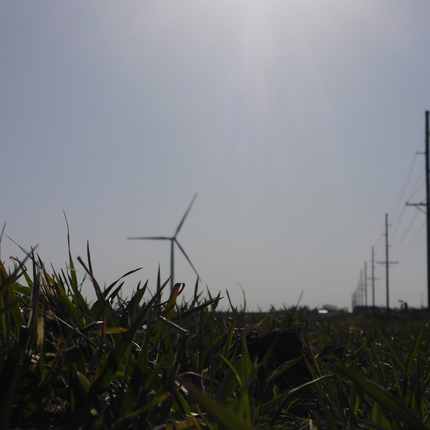Rhea Landholm contributed to this blog.
With states across the Midwest continuing to embrace the economic potential of renewable energy, project developers and landowners have the ability to work together to explore opportunities for investments in conservation, according to three new reports released by the Center for Rural Affairs.
The reports in the “Amplifying Clean Energy” series, authored by Cody Smith, outline steps project developers, utilities, and other stakeholders should take to plan for, install, and manage native vegetation on solar, wind energy, and transmission development sites.
Steps for selecting native seed mixes and recommendations for constructing, designing, and budgeting are also included.
In addition, policy considerations for both public officials and private parties are explored, including requiring the practice within county-level renewable energy ordinances and the adoption of statewide initiatives.
The first in the series, “Amplifying Clean Energy with Conservation Part One: Pollinator-Friendly Solar,” identifies opportunities to invest in native vegetation on solar sites.
“In addition to providing much-needed habitat for a variety of at-risk pollinators and wildlife, pollinator-friendly solar projects can cut operations and maintenance costs for project developers by three times when compared to traditional turfgrass management,” Cody said. “When solar developers adopt this commonsense practice, they’re amplifying the value of the clean energy they produce with investments in conservation while also cutting costs—ensuring the greatest possible return on investment for all stakeholders.”
The second, “Amplifying Clean Energy With Conservation Part Two: Leveraging Electric Transmission Lines for Stewardship,” explores how utilities, policymakers, and landowners can couple rights-of-way for energy infrastructure with investments in pollinator and wildlife habitat to benefit ratepayers.
“Electric transmission lines play a crucial role in any plans to expand renewable energy; fortunately, they can also double as habitat for vulnerable wildlife and pollinators, like monarch butterflies,” Cody said. “As the clean energy economy continues to expand, electric transmission lines will inevitably expand, offering up hundreds of thousands of miles for investments in natural resources conservation.”
Many electric transmission lines run through private farmland. Changes in the 2018 farm bill have allowed farmers and landowners to enroll land within these easements into farm conservation programs, like the Conservation Reserve Program. This could result in additional payments to farmers while protecting vulnerable species of wildlife and pollinators.
The final report, “Amplifying Clean Energy With Conservation Part Three: Exploring Wind Energy and Stewardship,” looks at opportunities for coupling investments in water quality improvement and pollinator habitat on wind project sites.
“With the impacts of climate change bearing down on rural communities, working together to leverage the rapidly-expanding wind energy industry to invest in conservation helps build resiliency,” Cody said. “In an effort to transition to a clean energy economy, rural communities are uniquely positioned to host new wind projects, as well as bring together all stakeholders to ensure the greatest return on investment for their communities.”
Wind turbines often occupy limited areas of land which allows for other unrestricted uses on project sites, including both farming and conservation.
“If project developers, landowners, and public officials want to amplify the value of each of these sites, conservation could help get them to that point,” Cody said.
Feature photo: Wind energy, solar energy, and transmission projects all provide opportunities for pollinator-friendly habitat and other types of conservation, according to a three-part report series released late last year. Check them out at cfra.org/publications. | Photo by Cody Smith





